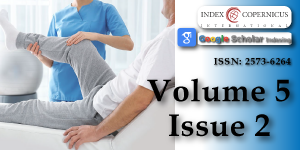A comparitive study on square stepping exercise versus balance training exercises on fear of fall and balance in parkinsonism patients
Main Article Content
Abstract
To study the effect of square stepping exercise and balance exercise to improve balance impairment and reducing the fear of falling on Parkinsonism patient. This is a pre-test and post-test experimental design comparative in nature. Subject aged between 60 – 70 years having Parkinson’s disease were included for the study. Group A (15 subjects) participated in square stepping exercise for 5 times in a week for 4 weeks and Group B (15 subjects) participated in balance exercise for 5 times in a week for 4 weeks. The outcome was measured by using Berg balance scale, Time up and go (TUG) test and fall efficacy scale. Statistical analysis done by using pair ‘t’ test and unpair ‘t’ test showed that there is significant improvement in subject who underwent the square stepping exercise program compared to balance exercise on fear of fall and balance in parkinsonism patients. It is concluded that square stepping exercise group exhibited statistically significant improvement in Berg Balance Scale, Time up and Go test score and fall efficacy test score compared to the balance training exercise group.
Article Details
Copyright (c) 2021 Mythili G , et al.

This work is licensed under a Creative Commons Attribution 4.0 International License.
Cynthiyanorkin PT. Biomechanics, 3rd edition 2004.
Kisner C, Colby LA. Therapeutic exercise foundation and technique, 6th edition, 2013.
Tinetti ME, Speechley M, Ginter SF. Risk factors for fall among elderly persons living in the community. N Engl J Med. 1988; 319: 1701-1707. PubMed: https://pubmed.ncbi.nlm.nih.gov/3205267/
Mancini M, Nutt JG, Horak FB. Balance dysfunction in Parkinson’s disease.
William Smith MS. The complete fitness guide to improve mobility, strength and Balance exercise for Parkinson’s Disease.
Incidence, Prevalence and Cost of Parkinson's disease. 2011. http://www.eng.ircminternational.com/2011/04/incidence-prevalence-and-cost-of- Parkinson’s-disease/
Ellis T, de Goede CJ, Feldman RG, Wolters EC, Kwakkel G, et al. Efficacy of a physical therapy program in patients with Parkinson's disease: A randomized controlled trial. Arch Phys Med Rehab. 2005; 86: 626-632. PubMed: https://pubmed.ncbi.nlm.nih.gov/15827910/
Heremans E, Nieuwboer A, Spildooren J, Vandenbossche J, Deroost N, et al. Cognitive aspects of freezing of gait in Parkinson's disease: A challenge for rehabilitation. J Neural Transm (Vienna). 2013; 120: 543-557. PubMed: https://pubmed.ncbi.nlm.nih.gov/23328947/
van der Kolk NM, King LA. Effects of exercise on mobility in people with Parkinson's disease. Mov Disorder. 2013; 28: 1587-1596. PubMed: https://pubmed.ncbi.nlm.nih.gov/24132847/
Özgönenel L, Çagirici S, Çabalar M, Durmusoglu G. Use of game console for rehabilitation of Parkinson'sdisease. Balkan Med J. 2016; 33: 396-400. PubMed: https://pubmed.ncbi.nlm.nih.gov/27606134/
Sherrington C, Whitney JC, Lord SR, Herbert RD, Cumming RG, et al. Effective exercise for the prevention of falls: A systematic review and meta-analysis. J Am Geriatric Soc. 2008; 56: 2234-2243. PubMed: https://pubmed.ncbi.nlm.nih.gov/19093923/
Nieuwboer A, Kwakkel G, Rochester L, Jones D, van Wegen E, et al. Cueing training in the home improves gait-related mobility in Parkinson's disease: The RESCUE trial. J Neurosurg Psychiatry. 2007; 78: 134-410. PubMed: https://pubmed.ncbi.nlm.nih.gov/17229744/
Shigematsu R, Okura T. A novel exercise for improving lower-extremity functional fitness in the elderly. Aging Clin Experie Res. 2006; 18: 242-248. PubMed: https://pubmed.ncbi.nlm.nih.gov/16804371/
Hoehn MM, Yahr MD. Parkinsonism: Onset, progression and mortality. Neurology. 1967; 17: 427-442. PubMed: https://pubmed.ncbi.nlm.nih.gov/6067254/
Berg KO, Wood-Dauphinee SL, Williams JI, Maki B. Measuring balance in the elderly: Validation of an instrument. Can J Public Health. 1992; 83: S7-11. PubMed: https://pubmed.ncbi.nlm.nih.gov/1468055/
Podsiadlo D, Richardson S. The timed “Up & Go”: A test of basic functional mobility for frail elderly persons. J Am Geriatr Soc. 1991; 39: 142-148. PubMed: https://pubmed.ncbi.nlm.nih.gov/1991946/
Harshika B, Vishnu V, Tushar P, Shilpa K. Comparative study on the effect of square stepping exercises versus balance training exercises on fear of fall and balance in elderly population. Int J Physiother Res. 2016; 4: 1352-1359.
Smania N, Corato E, Tinazzi M, Stanzani C, Fiaschi A, et al. Effect of balance training on postural instability in patients with idiopathic Parkinson's disease. Neuro Rehab Neural Repair. 2010; 24: 826-834. PubMed: https://pubmed.ncbi.nlm.nih.gov/21045119/
Rochester L, Baker K, Hetherington V, Jones D, Willems AM, et al. Evidence for motor learning in Parkinson's disease: Acquisition, automaticity and retention of cued gait performance after training with external rhythmical cues. Brain Res. 2010; 1319: 103-111. PubMed: https://pubmed.ncbi.nlm.nih.gov/20064492/
Teixeira CV, Gobbi S, Pereira JR, Vital TM, Hernandéz SS, et al. Effects of square-stepping exercise on cognitive functions of older people. Psychogeriatrics. 2013; 13: 148-156. PubMed: https://pubmed.ncbi.nlm.nih.gov/25913763/

